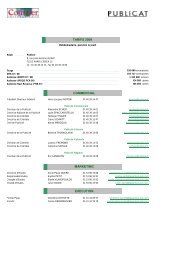2 ОРГАНИЗАЦИЯ И МЕТОДИКА РАБОТ - Courrier international
2 ОРГАНИЗАЦИЯ И МЕТОДИКА РАБОТ - Courrier international
2 ОРГАНИЗАЦИЯ И МЕТОДИКА РАБОТ - Courrier international
Create successful ePaper yourself
Turn your PDF publications into a flip-book with our unique Google optimized e-Paper software.
Commercial production of PCB began in 1929 in the US by Monsanto Company. They are oily<br />
liquids that are non-flammable, do not conduct electricity but conduct heat easily. PCB are resistant<br />
to acids and alkalis. Commercial mixtures of chlorination of diphenyl were marketed as Aroclor,<br />
Piranol, Inerteen (Monsanto, Westinghouse in USA), Clophen (Bayer, Germany), Fenclor (Caffaro,<br />
Italy), Kanechlor and Sibanol (Kanegafuchi, Japan),. Phenoclor and Piralen (Prodolec, France),<br />
Delor (Czechoslovakia).<br />
Commercial products based on PCB were widely used as dielectrics transformer and condenser<br />
oils, as cooling liquids in heat-exchange systems (coolants), hydraulic liquids, lubricating and seal<br />
oils as well as admixtures of herbicides. PCB were included in the composition of plasticizers for<br />
insulation materials and plastics and used as admixtures of paints, varnishes, adhesives and color<br />
paper for copying.<br />
In the former USSR and Russia, polychlorinated biphenyls were produced from 1934 through 1995.<br />
They were produced under trade marks of Sovol, Sovtol and Geksol. The main producers of Sovols<br />
were PA "Orgsteklo" (Dzerzhinsk), PA "Orgsintez" (Novomoskovsk) and VNITIG s (All-Union<br />
Research Institute of Herbicides, Ufa) experimental plant.<br />
The oils containing PCB mixtures was used in KSK condensers, which had been produced by SPA<br />
Kondensator" (Serpukhov) before 1988; and in power, high-voltage, pulse and other transformers to<br />
be produced in many places in Russia.<br />
Intake of polychlorinated biphenyls in the environment is associated with accidental leaks from<br />
controlled close systems such as commercial transformers, condensers, heat exchangers and<br />
hydraulic devices and also with uncontrolled release due to burning of production and domestic<br />
waste. During a long period of intensive use of PCB in industry in many countries of the world,<br />
huge amounts of these compounds have been released into the environment, and now the<br />
contamination with these xenobiotics affects the whole biosphere. PCB s physico-chemical<br />
properties provide a long life (years and decades) in abiotic environments and the capability to<br />
accumulate in bottom sediments, soils and fatty tissues of wildlife. Along with organochlorine<br />
pesticides, PCB are the most wide spread products contaminating water in natural water bodies. It is<br />
considered that PCB concentration in non-polluted fresh waters should not exceed 0.5 ng/l, while in<br />
moderately polluted waters 50 ng/l.<br />
Polychlorinated biphenyls (PCB) belong to the group of persistent organic pollutants (POP), the<br />
monitoring of which is obligatory in the industrially developed countries due to their high<br />
environmental and health hazard. Persistent organic pollutants (POP) are a group of organic<br />
compounds having toxic properties and are persistent and biologically accumulable and able to be<br />
transported for a long distance in different environments to lead to negative consequences for<br />
human health and the environment.<br />
PCB hazard for human health is, in the first place, that they impair immune system function<br />
( chemical AIDS). In addition, PCB intake in human organism leads to the development of cancer<br />
injury of liver, kidneys, nervous system and skin (neurodermatitis, eczemas and rashes). Penetrating<br />
into baby/fetus organism, PCB may cause congenital deformities (developmental delay, decrease in<br />
immunity and impairment of hematogenesis). However, the most hazardous PCB impact on human<br />
health is the mutagenic effect, which is detrimental to future generations.<br />
Heavy metals<br />
FINAL REPORT for Contract No. CS-NPA-Arctic-13/2009 of December 01, 2009 within the framework of pilot project Development of<br />
Technology of clean up of the area of Decommissioned Sites of The Russian Federation Ministry of Defense in the Arctic by the<br />
Example of Alexanra Island of Franz Josef Land Archipelago from Hazardous Waste<br />
74








